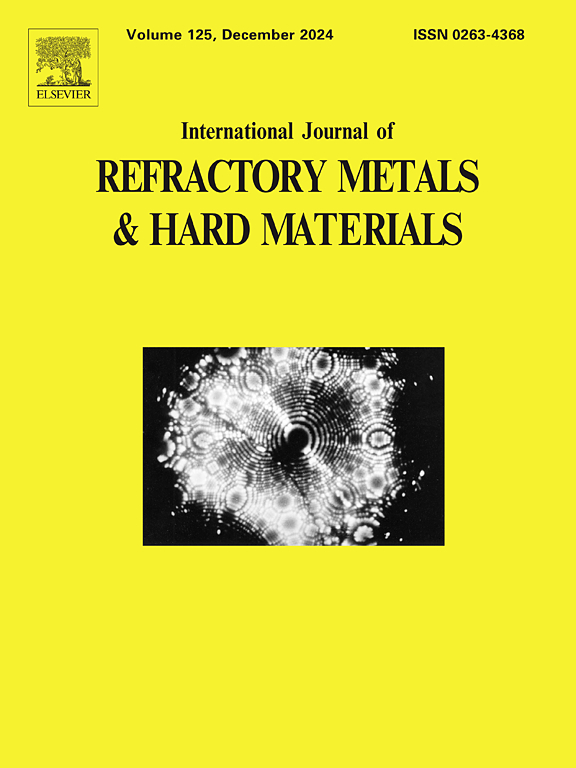激光定向能沉积制备CuNb合金:添加Ti对其组织和性能的影响
IF 4.2
2区 材料科学
Q2 MATERIALS SCIENCE, MULTIDISCIPLINARY
International Journal of Refractory Metals & Hard Materials
Pub Date : 2025-03-12
DOI:10.1016/j.ijrmhm.2025.107152
引用次数: 0
摘要
采用激光定向能沉积(LDED)技术在铜基体上制备CuNb合金,可有效提高其耐烧蚀性能。然而,由于CuNb界面结合较弱,导致合金的力学性能下降。为了解决这一挑战,我们提出了一种策略,即引入界面TiO来优化界面结构。Ti元素的加入使Nb的形态由细胞结构转变为细枝晶。结果表明,tio2界面相的形成使非相干Cu/Nb界面转变为半相干Cu/TiO/Nb界面,位错更容易通过该界面传递。因此,Cu-Nb-Ti沉积合金具有较高的总伸长率。此外,Cu-Nb-Ti沉积合金由于晶界强化和溶质固溶强化而表现出较高的强度,其中Cu-Nb-1.5Ti沉积合金的合成性能最为优异。本文章由计算机程序翻译,如有差异,请以英文原文为准。
The CuNb alloys prepared by laser directed energy deposition: Effect of Ti addition on microstructure and properties
Preparing Cu![]() Nb alloys on copper substrate by laser directed energy deposition (LDED) can improve the ablative resistance effectively. However, the mechanical properties of the Cu
Nb alloys on copper substrate by laser directed energy deposition (LDED) can improve the ablative resistance effectively. However, the mechanical properties of the Cu![]() Nb alloys deteriorate due to the weak Cu
Nb alloys deteriorate due to the weak Cu![]() Nb interfacial bonding. To address this challenge, we propose a strategy that an interphase TiO is introduced to optimize the interface structure. Adding Ti element can significantly transform the morphology of the Nb from cellular structure to fine dendrite. It was found that the formation of TiO interphase can transform the incoherent Cu/Nb interface into the semi-coherent Cu/TiO/Nb interface that the dislocations can transmit across more easily. Therefore, the Cu-Nb-Ti deposited alloys exhibit higher total elongation. In addition, the Cu-Nb-Ti deposited alloys exhibit higher strength due to the grain boundary strengthening and solute solution strengthening, and the Cu-Nb-1.5Ti deposited alloy achieves the most excellent synthetic performance.
Nb interfacial bonding. To address this challenge, we propose a strategy that an interphase TiO is introduced to optimize the interface structure. Adding Ti element can significantly transform the morphology of the Nb from cellular structure to fine dendrite. It was found that the formation of TiO interphase can transform the incoherent Cu/Nb interface into the semi-coherent Cu/TiO/Nb interface that the dislocations can transmit across more easily. Therefore, the Cu-Nb-Ti deposited alloys exhibit higher total elongation. In addition, the Cu-Nb-Ti deposited alloys exhibit higher strength due to the grain boundary strengthening and solute solution strengthening, and the Cu-Nb-1.5Ti deposited alloy achieves the most excellent synthetic performance.
求助全文
通过发布文献求助,成功后即可免费获取论文全文。
去求助
来源期刊
CiteScore
7.00
自引率
13.90%
发文量
236
审稿时长
35 days
期刊介绍:
The International Journal of Refractory Metals and Hard Materials (IJRMHM) publishes original research articles concerned with all aspects of refractory metals and hard materials. Refractory metals are defined as metals with melting points higher than 1800 °C. These are tungsten, molybdenum, chromium, tantalum, niobium, hafnium, and rhenium, as well as many compounds and alloys based thereupon. Hard materials that are included in the scope of this journal are defined as materials with hardness values higher than 1000 kg/mm2, primarily intended for applications as manufacturing tools or wear resistant components in mechanical systems. Thus they encompass carbides, nitrides and borides of metals, and related compounds. A special focus of this journal is put on the family of hardmetals, which is also known as cemented tungsten carbide, and cermets which are based on titanium carbide and carbonitrides with or without a metal binder. Ceramics and superhard materials including diamond and cubic boron nitride may also be accepted provided the subject material is presented as hard materials as defined above.

 求助内容:
求助内容: 应助结果提醒方式:
应助结果提醒方式:


